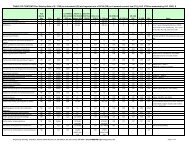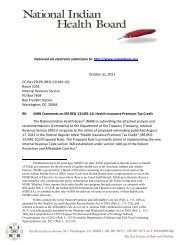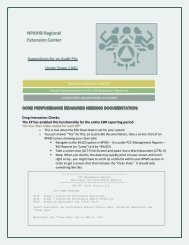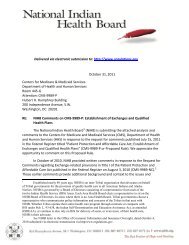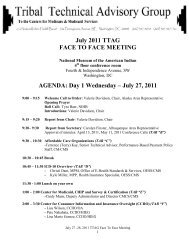mmpc - National Indian Health Board
mmpc - National Indian Health Board
mmpc - National Indian Health Board
Create successful ePaper yourself
Turn your PDF publications into a flip-book with our unique Google optimized e-Paper software.
Summary<br />
T<br />
he <strong>Indian</strong> <strong>Health</strong> Service (IHS) provides only part of the health care needed by the American <strong>Indian</strong>s and<br />
Alaska Natives (AIAN) who rely on the IHS health care system because of the limited funding<br />
appropriated to the agency by the federal budget. The largest alternate resource to IHS for the health<br />
care funding of AIAN who rely on the IHS health care system is Medicaid. Medicaid pays for care received<br />
not only at the IHS and tribally operated health care facilities, but from other providers when specialized or<br />
emergency care is needed. The federal Medicaid program pays 100% of state Medicaid claims from IHS health<br />
care system providers for IHS funded services provided to AIAN (IHS Program claims). Together with its<br />
companion program, the Children’s <strong>Health</strong> Insurance Program (CHIP), Medicaid has grown to provide a<br />
substantial but largely unknown fraction of the coverage of health care for the AIAN who use the IHS system.<br />
The first objective of this report to determine whether Medicaid (including the Medicaid portion of CHIP not<br />
operated by states alone) pays as much for the personal health care services of AIAN who rely on the IHS system<br />
of health care providers (IHS AIAN) as it does for other Medicaid recipients. If the per capita amounts paid for<br />
the IHS AIAN are comparable to those of others, then a basic measure of health care equity for AIAN served by<br />
the IHS system has been achieved. If not then efforts are needed to achieve equity.<br />
A second objective is to determine whether there are any Areas of the IHS health care delivery system, or<br />
subgroups of AIAN who rely on the IHS system that do not have Medicaid payment levels as high as those of<br />
other AIAN subgroups served by the IHS System. Where the payment levels for IHS AIAN are not as high as<br />
those of others in an Area, it can be because IHS AIAN have more difficulties obtaining Medicaid paid care, or<br />
because the state and IHS system provider need to work more closely to see that Medicaid claims are filed and<br />
paid successfully. If IHS system providers do not file and collect claims for services provided to Medicaid<br />
enrolled AIAN they serve, they are in effect substituting IHS funding for Medicaid funding of health care costs. In<br />
this report, analyzing only the Medicaid data of the counties of the IHS Areas allows comparison of payments<br />
across IHS Areas and using Medicaid data that has been linked with IHS registry data allows examination of<br />
AIAN subgroups served by the IHS System.<br />
A third objective of this report is to determine what fraction of the personal health care costs of the AIAN user<br />
population of the IHS system is actually provided by Medicaid payments. The IHS has current data on the<br />
Medicaid collections of the IHS and tribal facilities that they operate, but not the tribal facilities operated by<br />
tribes. About one-third of the IHS system facilities are tribally-operated facilities. The IHS estimates that about<br />
25% of the per capita costs of health care needed by AIAN they serve is paid by third-parties including Medicaid,<br />
Medicare and private insurance. The AIAN survey data on which this calculation is based is now more than 20<br />
years old, however. Medicaid payment data provides a way to update the Medicaid portion of the third-party<br />
payment fraction. In addition it offers a way to estimate how much this Medicaid fraction varies across IHS<br />
Areas. Determination of the fraction is critical because the IHS estimates that it provides only about 54% of the<br />
per capita costs of health care needed by AIAN they serve. The extent to which the 25% fraction is too high,<br />
underestimates the remaining unmet health care need of the AIAN, the extent to which the 25% fraction is too<br />
low overestimates the unmet health care need. The IHS allocates new federal funds it receives to the IHS and<br />
tribally-operated facilities based on its calculated estimates of the unmet health care need of the AIAN served by<br />
the facilities.<br />
To achieve the first two objectives, after excluding longterm care and institutionalized Medicaid recipients the<br />
per capita payments for six different types of Medicaid recipients of the remaining medical, behavioral health





